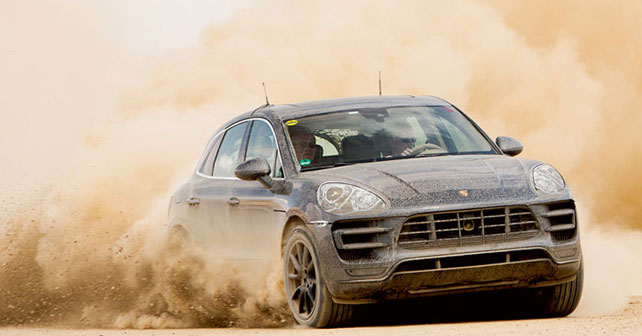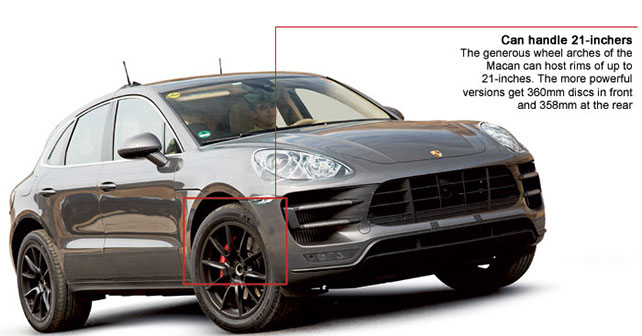We tag along with the Porsche road-testers all the way to the dirt trails of California, as they put the finishing touches on the compact SUV from Stuttgart. First impressions are that it’s more than a little naughty.
Brakes on, turn-in, pedal to the metal, exit. At this point, no counter-steer is necessary since we’re swerving from one curve to the next in a vehicle that’s 4.6 metres long, has all-wheel drive, and high ground clearance. Yes, this is the new Porsche SUV – the Macan.
Finishing touches
We’re in the Californian mountains, behind Los Angeles, in the company of the Porsche engineers in charge of development. Their task is to test the new driver assistance systems, and harmonize the interaction between engine and transmission – all the while keeping in mind pitch and engine note. After all, like the sports cars in the family – the Cayman and 911 – this too must faithfully obey the driver and offer impeccable driving characteristics. Hans-Jürgen Wöhler, the engineer responsible for the setup of all Porsche SUV’s, has a refined ear – nothing escapes him, not even the slightest creak from the inner linings of the (pre-production) prototype that we’re testing. He’s not satisfied. On the other hand, while he enjoys the brief ‘bark’ while changing up at 5,000rpm, he would like the gear change to be even more incisive.
No climbing, far from it
Wöhler shows us the spontaneity with which the new 3-litre V6 of the Macan S responds to the commands of the accelerator. According to him, no ‘void’ caused by the response times of the turbo can be noticed. We could, however, decipher a minor delay, at low revs, between the pressure on the accelerator and the forward thrust of this beast. Though all things considered, it’s an insignificant detail in the general impression left by the new compact Porsche SUV that’s based on the Audi Q5. But the modifications carried out by the designers in Zuffenhausen are numerous. For example, in the Macan, the seating position of the driver is lowered by 25mm. The sporty seats have been lifted directly from the Cayenne. Access to the cabin is not elevated, as is typical of an SUV. On the contrary, you actually have to lower yourself slightly to get into the driver seat. In addition to the lower seats, in fact, the car body has been lowered by 20mm when compared with the Q5.
Moreover, at first sight, the Macan is more reminiscent of a narrower Cayenne than a revised Q5. The relation between the glass area and the underlying sheet metal makes it look like the most aggressively crouching Porsche ever. The bulging wheel arches are designed to house 21-inch rims to give it an even more muscular stance. Meanwhile, the enormous vents up front confer an expression of evil – while the front and back aprons, lowered considerably, give it a further sense of being planted firmly on the ground. All in all, the Macan presents a decidedly more aggressive ethos to that of its Audi ‘cousin.’ Not only that, the near complete closing off of the underbody allows it to achieve better aerodynamic performance, as confirmed by Oliver Laqua – the project manager of the Macan. As far as the engines are concerned, Porsche offers two petrol engines and one diesel. The new V6 bi-turbo 3.0-litre delivers 340bhp and a maximum torque of 460Nm. The Macan’s now famous 3.6 litre V6, with twin-turbocharging, boasts of 400bhp and 500Nm torque, while the 3-litre V6 turbo-diesel has 258bhp and 580Nm. Those expecting the debut of the new 2-liter, 4-cylinder boxer engine, however, will be let down – its development remains so secretive that they even deny its existence.
All in the back
The transmission will feature the famous 7-gear, double-clutch gearbox, and, obviously, all-wheel drive. Under normal conditions, 85% of the torque is transferred to the rear axle. However, if necessary, every axle can transmit up to 90% of the engines’ toque onto the road. What is noteworthy is that Porsche, unlike Audi, does not use a Torsen differential as a splitter. Instead, it relies on a multi-plate clutch – the same configuration found on the Cayenne. This solution allows the reduction of both weight and fuel consumption. Plus, in practical terms, it amounts to an unwritten recommendation – drive this SUV only on asphalt. Porsche makes a small concession with the Macan Turbo – equipped with air suspension – by including an ‘off-road’ switch, similar to the one present on the Cayenne. This allows the ride height to be raised by 40mm up to speeds of 120km/h. It also modulates the ESP, and sets up a longer throttle pedal to ease its operation off-road.
All told, the German designers leave us with the conviction that the new Macan is indeed the sportiest of all SUV’s presently available on the market. We’re even convinced that this new model from Zuffenhausen represents the most sporty of the Porsche models following the 911 and the Cayman. In other words, pseudo-sport SUV’s have been warned – starting next year they’ll have quite a contender to deal with.
Lowered Structure
Based on the Audi Q5, the Macan is lower than its Ingolstadt cousin. Air suspension, which can lower the ride height by 40mm, is standard with the 400bhp, 3.6-litre turbo engine
Derived from the Q5, but...
Only turbocharged V6 engines, with the power-split biased towards the rear wheels
The latest from Zuffenhausen
Production Macan unveiled at the LA Auto Show
The Macan was unveiled at the Los Angeles Auto Show in the third week of November, and the final production version that you see below is a stunning machine. It looks a lot more aggressive and svelte than its bigger brother, the Cayenne. The rear end, especially, is far sleeker than the camouflaged test mule pictured over the last few pages. The ‘Turbo’ variant is powered by a twin-turbo 3.6 litre engine producing 400bhp, which propels the Macan Turbo to 100km/h in just 4.8 seconds. The S version gets a 3.0 twin-turbo producing 340bhp, while the sole diesel in the lineup has a 3 litre 258bhp turbo-diesel. All engines are mated to Porsche’s 7-speed PDK, and deliver power to the road through all four wheels.
© Riproduzione riservata


























Write your Comment